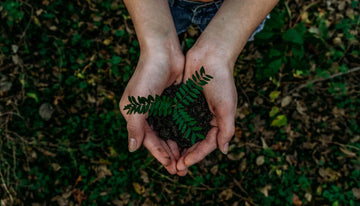When we think about what future generations will have to experience, it is hard to wrap our heads around. In many ways, society has improved – health care and technology have made massive advances – but in many ways, the previous generations have failed us. The most noticeable failure is that they have left the planet in worse shape than when they inherited it.
The decline of our planet’s ecosystems has driven many people to want to create green, eco-friendly, and sustainable lifestyles for themselves and their families. So, what is sustainability? And why does it really matter?
What is Sustainability?
According to the United States Environmental Protection Agency, sustainability stems from one basic principle: everything that we human beings need for our well-being and survival depends, both directly or indirectly, on our natural environment.
To offer sustainability means to create conditions and maintain them under which nature and humans can exist in harmony to support the current and future generations. Sustainable living involves finding responsible ways to live that protect the earth.
Keep in mind, there are also economic and social sustainability problems that you should also consider so the world can be a healthy, habitable, and safe place for everyone. You and your family would need to switch to a lifestyle that doesn’t contribute to the consumption of nonrenewable resources and the production of pollutants.
Why Does Environmental Sustainability Matter?
To protect the environment, you can start by recycling, conserving water, or powering off electronics when we leave the house. Businesses are regulated to keep carbon emissions low and prevent pollution. Environmental protection is one of three pillars of sustainability efforts and is the main concern for the future of the human race.
Environmental sustainability is defined as the study and protection of air quality, ecosystems, sustainability of natural resources, and all of the other things that can affect the environment. Environmental sustainability also concerns how technology can be used to create a greener future.
There are two main ways where environemtnal sustainability can be acheived: this is by individuals and government bodies/corporations. Individuals can take small steps to acheive a more sustainable lifestyle. While the steps may be small, they’re still effective. This could be consuming less meat, reducing the amount of water used, or switching to reusable products to reduce single-use plastic.
According to Emeritus, sustainable living not only helps reduce pollution but also helps conserve natural resources like energy and water. People and businesses that care about sustainability are also less likely to intrude upon natural habitats. This helps protect the planet's biodiversity.
Government bodies and corporations can switch to renewable energy in places like offices, warehouses, and factories or even change their products/packaging to completelely get rid of or lessen the amount of single-use plastic used in the manufactoring process.
Developing technology is key when it comes to sustainability and protecting the environment from future damage. A healthy environment means healthy communities and healthy people. That is why environmental sustainability matters.
Why Does Social Sustainability Matter?
Social sustainability helps ensure that cultures can and will survive for future generations to experience and enjoy. The best way we can do this is with awareness and protection. For example, there has been a recent wave involving social pressure on individuals and businesses to do more for the environment. Because of this wave there has also been an increase in self-education on how to protect and care for the environment.
Social sustainability is also about maintaining access to resources for everyone without reducing the quality of life. A good example of where we need to improve is sustainable housing and communities. We can encourage sustainable housing by being involved in initiatives that encourage a higher density transit-oriented development, green construction, healthy homes, as well as incorporating architectual designs that promote neighborhood walkability.
Some exmaples of how we can make society more sustainable are we can design cities to be more walkable and public transit friendly, a city-wide recycling program to support recycling, and sustainable power can be used.
Lastly, we have education. We need to encourage people to practice sustainability and teach them the importance of protecting the environment, ways that we can help on individual and societal levels, and the dangers that can arise if we don’t meet our sustainability goals.
Why Does Economic Sustainability Matter?
Economic sustainability is arguably the most problematic of the three sustainability issues.
The goal of economic sustainability is a successful economy that operates in a sustainable manner.
This is because most people disagree on what is and isn’t economically sound and how said things will affect businesses, employment, and jobs. Ideally, jobs should be fairly paid that allow people to take care of themselves and their families. It is about ensuring fair practices for both consumption and production that won’t sacrifice the planet both short-term and long-term.
Where Does Sustainability Start in Families?
There are a lot of ways for families to adopt a more sustainable lifestyle, but a great place to start with small things. Here are 3 sustainability examples:
- Reduce waste everywhere you can. This can be done by changing from plastic water bottles to reusable ones, using reusable bags instead of plastic bags at the grocery store, unplugging electronics when leaving the house, recycling, and buying green products.
- Economically support companies and organizations that operate with sustainable measures and are committed to ethical manufacturing.
- Spread the message of sustainability as much as you can.
This may not seem like much but trust us, little changes add up. Those little changes can be huge if thousands of people are all making those small changes.
A good place to start is to think about the food that you eat. It’s really important to know where you food comes from when it comes to sustainability. Food transportation is one of the biggest causes of pollution today. Instead of supporting large chains, buy local. By purchasing food locally, you’re removing the need for food to be transported thousands of miles. Not only are you helping the environment but you’re also promoting social and economic sustainability by helping support local famerers, workers, and businesses incomes.
Once you feel confident in the little changes you make, you can branch out and add more sustainability efforts into your lifestyle. Whether it be adding more small efforts or one big one like going vegan.
Why You Should Choose Doshi Vegan Products
Vegan products are becoming more widely available these days, thanks to people adopting a cruelty-free lifestyle and more vegan brands popping up. Here at Doshi, we want to encourage and support people in buying and wearing vegan and ethical products. Here's why you should choose us:
- We’re purposefully cruelty-free and animal-friendly. No animal products are used in our products creation and creation process. We’re devoted to supporting organizations that protect animal rights from beginning to end. Purchasing from us is an investment in animal activism.
- We’re purposefully environmentally friendly. Our products are made in the most environmentally conscious way possible. We constantly push for better eco-friendly production and sustainability.
- We use only the best materials. Our founder dedicates his time to hand-selecting all the materials that go into our belts. That means leather alternatives and high-quality vegan leather sourced from around the world and made to last a lifetime.
- The craftsmanship we put into every product is second to none. Every one of our products, including our belts, is handmade by a skilled artisan. They’re one-of-a-kind pieces.
- All of our products are rigorously tested for quality. We’re rapid-fire unfastening, tightening, pulling, and sliding to find all the usual and unusual problems. This is so we can fix them before the product is in your hand.
- Our products are designed to be sleek, sophisticated, and straightforward. Our products give you the big-brand design standards without the big-brand environmental guilt or animal cruelty.
Materials Used In Our Products
There is a wide variety of leather alternative materials, some more popular than others. Keep the below materials in mind when choosing a vegan wallet.
Paper
Believe it or not, paper is an excellent alternative to leather. Of course, the "fabric" used is paper; it’s not the most durable leather alternative option, but it’s more durable than you think. An example of its incredible durability can be seen in our Debut Paper Backpack.
These wallets are extremely thin and light; the paper fabric has significant pros. This is it is 100% recyclable and the use of otherwise discarded materials being used in the production of new products.
Polyurethane
Polyurethane, a common type of vegan leather, is a product that uses a combination of synthetic and natural ingredients. In appearance, polyurethane can look highly similar to genuine leather, which makes it a great alternative aesthetically.
Polyurethane isn’t the best leather alternative, but it’s a solid choice because the fact that it uses fewer resources than leather to make makes it more sustainable. Not only does it use fewer resources than leather, but polyurethane products also cost less than genuine leather because it’s easier to manufacture.
On top of its lesser cost and requiring fewer resources, polyurethane doesn’t dry out over time and doesn’t absorb water, which makes it easy to clean.
Cork
Cork is one of the alternatives that best mimics leather regarding function and form. The production process of cork sheets is pretty straightforward. Cork is an easily recycled, completely natural product. It comes from cork oak trees which are harvested every nine years and have a life span of over two hundred years. This makes it a sustainable material to use.
Cork planks are left out to dry for about six months to get them flat and improve the quality. This results in cork planks that are then treated with fungicide and heated water to remove dirt and make the materials flexible. The cork is then pressed into blocks that are later sliced into thin sheets that are used for cork products.
Leather has a lot of heavy chemical processing; cork production is almost entirely chemical-free.
A Sustainable Future

We hope you enjoyed our list of 8 tips for sustainable living! We could add more tips to this list, but we wanted this guide to be a simple but efficient starting point. We want to encourage and support people in supporting the planet, that’s why we love sharing great options here on the Doshi blog!
Here at Doshi we design our products to be practical and useful; we choose materials and construction methods that are meant to hold up to frequent use, we pay our suppliers for the more difficult work we demand, and we stand behind our goods.
When we set about to make a product, we consider the materials being used, how the product is being made, and look to find ways that we can make the product last. Synthetic materials have made huge strides in minimizing the resources used to create them. We do our best to find factories that purchase recycled base material and minimize the use of chemicals and solvents when making their materials.
Eco-friendliness and sustainability are a function of how long a product lasts and what materials it's made from. We will continue to push on every frontier until we make beautiful products that are beautiful, last long, and then disappear back into the earth when we are done using them.
For more information on our sustainability efforts, check out our about us page.











